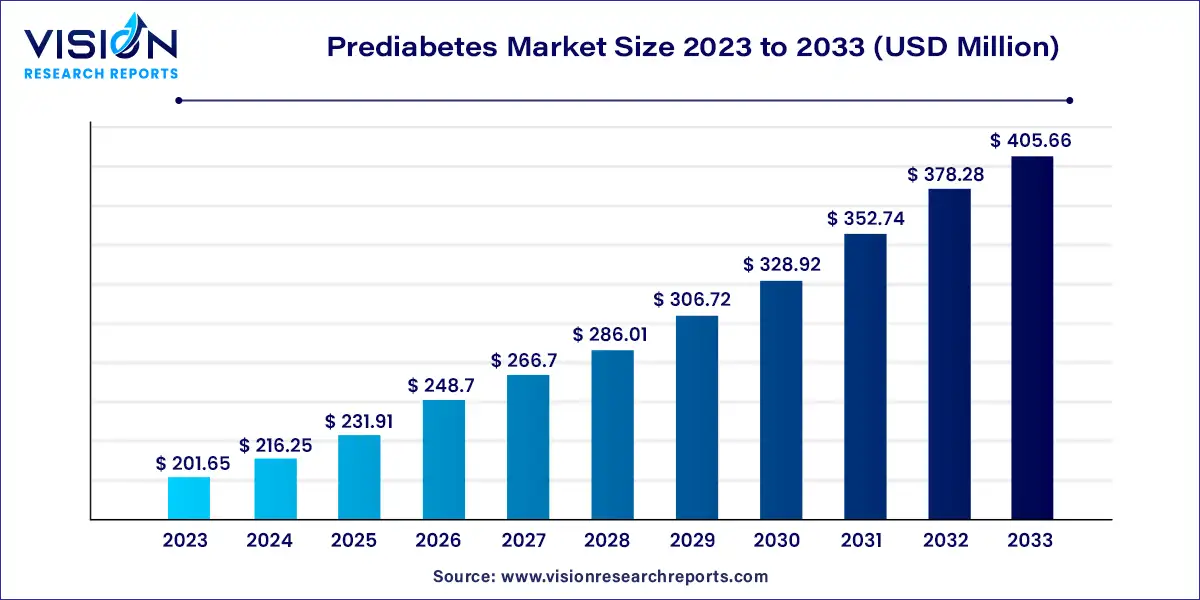The global prediabetes market was estimated at USD 201.65 million in 2023 and it is expected to surpass around USD 405.66 million by 2033, poised to grow at a CAGR of 7.24% from 2024 to 2033.

Prediabetes represents a critical healthcare challenge worldwide, characterized by elevated blood sugar levels that are not yet within the diabetic range. With its prevalence on the rise, the prediabetes market has garnered significant attention from healthcare professionals, researchers, and pharmaceutical companies alike.
The market landscape encompasses a diverse array of diagnostic tools, treatment options, and preventative measures aimed at managing and mitigating the progression of prediabetes to full-blown diabetes. From lifestyle interventions such as dietary modifications and increased physical activity to pharmacological interventions including metformin and other medications, there exists a spectrum of approaches to address this burgeoning health concern.
The growth of the prediabetes market is propelled by an escalating prevalence of prediabetes worldwide, driven by sedentary lifestyles, unhealthy dietary habits, and rising obesity rates, underscores the urgent need for effective interventions. Additionally, increasing awareness among healthcare professionals and the general population about the risks associated with prediabetes and its progression to diabetes has spurred demand for diagnostic tools and preventative measures. Furthermore, advancements in medical technology and research, leading to the development of innovative diagnostic tests, personalized treatment options, and novel therapeutics, are driving market growth. Moreover, supportive government initiatives aimed at promoting early detection and management of prediabetes, coupled with reimbursement policies for diagnostic tests and interventions, are contributing to market expansion.
In 2023, the adult segment (aged 18-49) dominated the market, commanding the largest revenue share at 49%. This age group, encompassing individuals between 18 and 49 years old, exhibits the highest prevalence of prediabetes. For instance, as per 2021 estimates from the CDC, approximately 38% of all U.S. adults fall into this category. The substantial prevalence of prediabetes in this demographic, compounded by the adoption of unhealthy lifestyles, fuels the growth of this segment.
Meanwhile, the elderly segment is poised to experience significant growth with a promising compound annual growth rate (CAGR) during the forecast period. Defined as individuals aged 50 and above, this demographic is particularly susceptible to developing prediabetes due to age-related metabolic changes. According to CDC data, an estimated 27.2 million people aged 65 and older in the U.S. have prediabetes as of 2021. The expanding global elderly population, coupled with the increasing availability of medication options for prediabetes treatment, is expected to propel the growth of this segment.
In 2023, the diguanides segment emerged as the market leader, capturing the largest revenue share at 84%. Diguanides, which include metformin, constitute a prominent drug class utilized in the management of prediabetes and type 2 diabetes. Metformin, in particular, stands out as the most prescribed diguanide for prediabetes treatment. As of August 2023, it holds the distinction of being the sole medication recommended by the American Diabetes Association (ADA) for managing prediabetes in both adult and pediatric patients aged 10 and above, according to the National Center for Biotechnology Information (NCBI). The identification of individuals with prediabetes often involves considering a glycated hemoglobin A1C test range of 5.7-6.4% (39-47 mmol/mol) as reasonable, as outlined in the Standards of Medical Care in Diabetes 2022.
Concurrently, the SGLT2 inhibitors segment is poised for significant growth, anticipated to achieve a lucrative compound annual growth rate (CAGR) during the forecast period. SGLT2 inhibitors have garnered increasing attention for prediabetes treatment in recent years. This class of drugs functions by inhibiting the reabsorption of sugar from urine, resulting in glucose excretion and decreased blood sugar levels. Notable drugs in this category include dapagliflozin, sotagliflozin, canagliflozin, empagliflozin, and ertugliflozin. The comparatively favorable side effect profile and high efficacy of SGLT2 inhibitors contribute to their role in driving market growth
In 2023, the North America region emerged as the market leader, commanding a revenue share of 42%. The region's dominance is attributed to several factors, including heightened awareness regarding the significance of early detection and intervention for prediabetes. With increasing prevalence rates, the market experiences expansion driven by initiatives aimed at addressing prediabetes risk factors. For instance, data from the American Diabetes Association (ADA) in 2021 revealed that 97.6 million adults aged 18 and above in the U.S. were diagnosed with prediabetes.
Meanwhile, the Asia Pacific region is poised for rapid growth, expected to achieve the fastest compound annual growth rate (CAGR) during the forecast period. This growth can be attributed to several factors, including increasing urbanization and the adoption of sedentary lifestyles, which contribute to the rising prevalence of prediabetes. Additionally, genetic predisposition and dietary habits, such as high consumption of sugary and processed foods, play a significant role in predisposing individuals to prediabetes in the region. Moreover, aging populations and shifting demographics further contribute to the escalating burden of prediabetes across Asia Pacific.
By Drug Class
By Age group
By Region
 Cross-segment Market Size and Analysis for
Mentioned Segments
Cross-segment Market Size and Analysis for
Mentioned Segments
 Additional Company Profiles (Upto 5 With No Cost)
Additional Company Profiles (Upto 5 With No Cost)
 Additional Countries (Apart From Mentioned Countries)
Additional Countries (Apart From Mentioned Countries)
 Country/Region-specific Report
Country/Region-specific Report
 Go To Market Strategy
Go To Market Strategy
 Region Specific Market Dynamics
Region Specific Market Dynamics Region Level Market Share
Region Level Market Share Import Export Analysis
Import Export Analysis Production Analysis
Production Analysis Others
Others